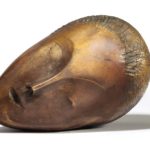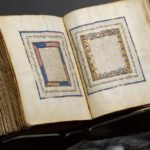
Portland, ME.- The Portland Museum of Art is proud to present “John Marin: Modernism at Midcentury”, on view at the museum until October 10th. Later in the year, the exhibition can be seen at the Amon Carter Museum of American Art in Fort Worth. John Marin sought Maine as a subject—its islands, mountains, beaches, and rocky shores—from 1917 onward. However, when he landed on Cape Split in 1933, he knew this remote and untamed northern locale would imprint his work, foregrounding the abstract properties that had always been a feature of his painting. Featuring 54 works, this exhibition will concentrate on the late period of John Marin’s (1870–1953) career. It will explore the interrelationship between his watercolors, sketchbooks, and oil paintings from 1933 to 1953. Marin sensed the radical potential of painting on Cape Split, transforming the ephemeral patterns of waves in their alternative states of turbulence and calm into innovative compositions, forecasting, as it turns out, some of the primary features and preoccupations of mid-century American art.
Marin grew up in Weehawken, New Jersey, and attended the Stevens Institute of Technology for a year. His experience with architecture might have contributed to the role played by architectural themes in his paintings and watercolors. Marin is often credited with influencing the Abstract Expressionists. He was among the first American artists to make abstract paintings, and his treatment of paint—handling oils almost like watercolors—his forays into abstraction, and his use of evocative stretches of bare canvas caught the eye of younger painters. From 1899 to 1901, Marin attended the Pennsylvania Academy of the Fine Arts in Philadelphia. In Philadelphia he studied with Thomas Pollock Anshutz and William Merritt Chase. He also studied at the Art Students League of New York. In 1905 like many American artists Marin went to Europe, initially to Paris. He traveled through Europe for six years. Marin painted in Holland, Belgium, England, and Italy. In Europe he mastered a type of watercolor where he achieved an abstract ambience, almost a pure abstraction with color that ranges from transparency to translucency, accompanied by strong opacities, and linear elements, always with a sense of freedom, which became one of his trademarks. In 1909, Marin held his first one-man exhibition at Alfred Stieglitz’s gallery, 291 in New York City.

The photographer Edward Steichen, whom Marin had met through the painter Arthur B. Carles, introduced him to Stieglitz. Marin’s and Stieglitz’s association would last nearly forty years. Stieglitz’s support, in both philosophical and financial respects, was essential to Marin. From 1909 until his death in 1946, Stieglitz showed Marin’s work almost every year in one of his galleries. Marin spent his first summer in Maine in 1914 and, almost immediately, the rocky coast there became one of his favorite subjects. Over the rest of his life, Marin became intimately familiar with the many moods of the sea and sky in Maine. “In painting water make the hand move the way the water moves,” Marin wrote in a 1933 letter to an admirer of his technique. In 1936, he had a retrospective show at the Museum of Modern Art. His paintings are represented in several important permanent collections and museums including: the Metropolitan Museum of Art, the Museum of Modern Art, the Whitney Museum of American Art, the Brooklyn Museum, the Cleveland Museum of Art, the Art Institute of Chicago, the National Gallery of Art, Washington, D.C., the Fogg Art Museum, Cambridge, Massachusetts, and many others. Late in life Marin achieved tremendous prestige as an American painter, an elder statesman of American art. In 1950, he was honored by the University of Maine and Yale University with honorary degree’s of Doctor of Fine Arts. A resident of Cliffside Park, New Jersey, he died at his summer home in Addison, Maine. In December of 2009, independent filmmaker Michael Maglaras of 217 Films released a feature length documentary about this American master titled “John Marin: Let the Paint be Paint!”

The Portland Museum of Art, founded in 1882, is Maine’s oldest and largest public art institution. The Museum’s architecturally significant buildings unite three centuries that showcase the history of American art and culture. The Museum’s collection of more than 17,000 objects includes decorative and fine arts dating from the 18th century to the present. The heart of the Museum’s collection is the State of Maine Collection, which features works by artists such as Winslow Homer, Marsden Hartley, Rockwell Kent, John Marin, Louise Nevelson, and Andrew Wyeth. The Museum has the largest European art collection in Maine. The major European movements from Impressionism through Surrealism are represented by the Joan Whitney Payson, Albert Otten, and Scott M. Black Collections, which include works by Mary Cassatt, Edgar Degas, René Magritte, Claude Monet, Edvard Munch, Pablo Picasso, and Auguste Rodin. The Elizabeth B. Noyce Collection, a bequest of 66 paintings and sculptures, has transformed the scope and quality of the Museum’s American collection, bringing to the Museum its first paintings by George Bellows, Alfred Thompson Bricher, and Jamie Wyeth, and adding masterpieces to the collection by Childe Hassam, Fitz Henry Lane, and N. C. Wyeth. In addition to exhibitions, the Museum has constantly changing educational programs, family festivals, lectures, art classes, musical concerts, bookgroups, art camps, gallery talks, and much more. Originally founded as the Portland Society of Art, the Museum used a variety of exhibition spaces until 1908. That year Mrs. Margaret Jane Mussey Sweat bequeathed her three-story mansion, now known as the McLellan House, and sufficient funds to create a gallery in memory of her late husband, Lorenzo de Medici Sweat. Noted New England architect John Calvin Stevens designed the L. D. M. Sweat Memorial Galleries, which opened to the public in 1911. Over the next 65 years, as the size and scope of the exhibitions expanded, the limitations of the Museum’s galleries, storage, and support areas became apparent. In 1976, Maine native Charles Shipman Payson promised the Museum his collection of 17 works by Winslow Homer. Recognizing the Museum’s physical limitations, he also gave $8 million toward the building of an addition to be designed by Henry Nichols Cobb of I. M. Pei & Partners. Construction began on the Charles Shipman Payson Building in 1981, and within two years the $8.2 million facility was opened to the public. In January 2000, the Museum launched a $13.5 million capital campaign to raise funds for the preservation, educational interpretation, and reopening of its two historic structures: the McLellan House (1801) and L. D. M. Sweat Memorial Galleries (1911). Completed in October 2002, the preservation project reunited these two buildings with the Payson building and returned the McLellan House to its original Neoclassical elegance and the L. D. M. Sweat Memorial Galleries to their original Beaux-Arts splendor.
The L. D. M. Sweat Memorial Galleries showcase the Museum’s outstanding collection of 19th-century American art. The Museum purchased the Winslow Homer Studio in Prouts Neck, Maine, in January 2006. The Studio is where the great American artist Winslow Homer (1836-1910) lived and painted many of his masterpieces from 1883 until his death. The Museum is currently engaged in a major capital campaign to raise $8.3 million for the acquisition, preservation, and endowment of the Studio. A National Historic Landmark, the restored Winslow Homer Studio will be used to celebrate the artist’s life, to encourage scholarship, and to educate audiences about the artistic heritage of Winslow Homer and Maine. The Studio and the surrounding grounds are closed to the public while construction and restoration projects take place. The Museum plans to complete this project in 2012. Recently, the Museum purchased two adjacent properties on Spring Street. In 2007, the Museum purchased 87 Spring Street to provide space for long-range expansion. In February 2008, the Charles Quincy Clapp House (1832), at 97 Spring Street, reverted back to the Museum from the Maine College of Art. Located next to the McLellan House, the Charles Q. Clapp House was built in 1832 by Portland businessman Charles Q. Clapp as a private residence. Cited as one of the America’s finest examples of Greek Revival architecture, the building is on the National Register of Historic Places. The Museum plans to restore this building to its original elegance and complete the Museum’s campus. Currently the Museum is visited by 160,000 visitors a year, approximately 10,000 of whom are school children. Museum membership is at an all-time high of 8,000 members and continues to grow. Now and into the future, the Museum is committed to serving as a dynamic center for the visual arts and strives to be an essential resource for the people of Maine and New England. Visit the museum’s website at … http://www.portlandmuseum.org







